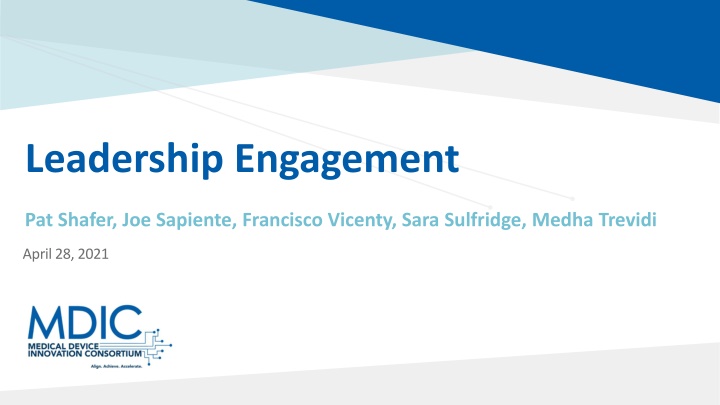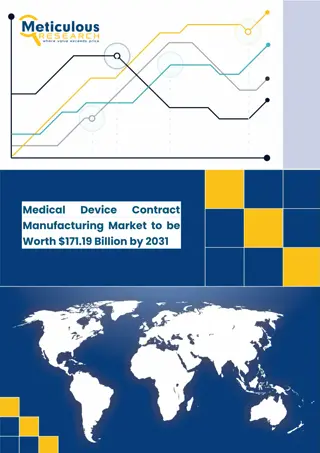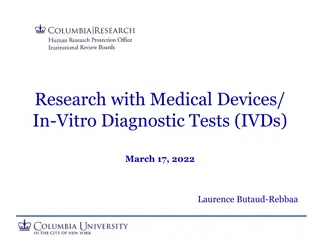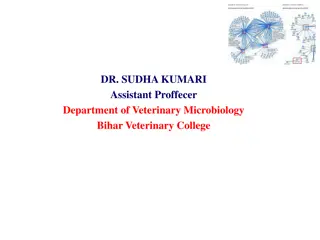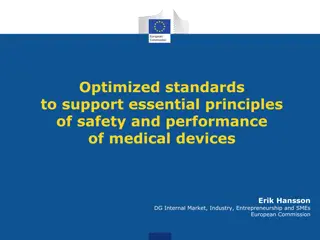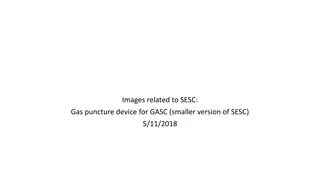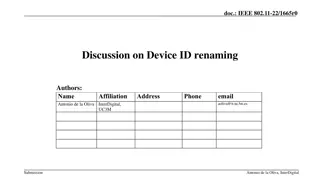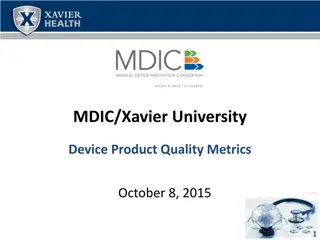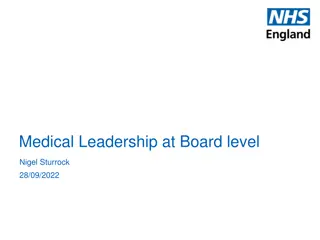Leadership Engagement for Quality Transformation in Medical Device Companies
Move from a culture of compliance to quality by influencing CEOs and key leaders, prioritizing quality over cost, and engaging employees. The mission is to promote quality as a strategic priority through strong leadership and alignment. Strategies include identifying and rationalizing cultural practices, capturing industry baselines, and developing playbooks. The baseline study shows the importance of leadership in promoting quality. Employees play a crucial role in maintaining quality standards, with a focus on prevention over reaction. Quality planning, training, and communication are essential in connecting individual roles to organizational quality objectives. Regular training and events reinforce this connection.
Download Presentation

Please find below an Image/Link to download the presentation.
The content on the website is provided AS IS for your information and personal use only. It may not be sold, licensed, or shared on other websites without obtaining consent from the author.If you encounter any issues during the download, it is possible that the publisher has removed the file from their server.
You are allowed to download the files provided on this website for personal or commercial use, subject to the condition that they are used lawfully. All files are the property of their respective owners.
The content on the website is provided AS IS for your information and personal use only. It may not be sold, licensed, or shared on other websites without obtaining consent from the author.
E N D
Presentation Transcript
Leadership Engagement Pat Shafer, Joe Sapiente, Francisco Vicenty, Sara Sulfridge, Medha Trevidi April 28, 2021
Our Mission 15+ Move from a culture of compliance to a culture of quality Influence CEOs and key leadership of medical device companies to lead / champion quality initiatives in a meaningful way that will effect positive change in their organizations and the industry. Promote Quality as a "strategic priority" being integral to all parts of an organization through strong leadership, strategic alignment, and tone at the top. Team members Joseph Sapiente Pat Shafer Sara Sulfridge Robin DiNardo Medha Trivedi Prakash Patwardhan Jackie Torfin Ramakrishna Pidaparti George Zack Segolene Balling Ashley Johnson Alan Baumel Jon Hunt Stephanie Christopher Steve Silverman Paul Arrendell Neil Kelly Jason Amaral Approach Identify and Rationalize Culture Practices Capture Industry Baseline Collect Industry Best Practices Develop Playbook Pilot Playbook 2
Culture of Quality Baseline 15+ 88 complete responses, baseline average is 71% agree or strongly agree Strongly Agree or Agree Strongly Agree or Agree Neutral or Disagree Neutral or Disagree Leadership promotes quality Engage to understand behaviors that drive quality 33% 33% 67% 67% 9% 9% 91% 91% Prioritize quality over cost Effectively communicated quality strategy 22% 22% 78% 78% 37% 37% 63% 63% Quality and my role Focus on prevention over reaction 53% 53% 47% 47% 10% 10% 90% 90% Quality in performance reviews Formally measure cost of quality 61% 61% 39% 39% 16% 16% 84% 84% Objective quality performance measures Benchmark and share best practices 43% 43% 57% 57% 10% 10% 90% 90% Would most employees agree with leadership's view of themselves? Would most employees agree with leadership's view of themselves? 3
Quality and My Role 15+ Planning, training and communication help define our role with respect to Quality 1. One consistent overriding theme is there is a clear connection between quality goals and objectives for the organization and what is performed by any individual in the organization. Organizations may often achieve these connections through a variety of quality planning activities. 2. Focusing on behaviors that are understood by all staff including identifying value statements as a part of training, a slogan, a credo or a motto. The goals of these statements are to create a culture that drives towards ensuring quality, understanding of how work performed impacts patients, and driving improvement effort. Examples of these may be provided in statements such as: We all speak up when we notice something wrong in a blame free environment We all share and implement ideas to continuously improve processes and procedures We all understand how our actions affect patients Quality isn t someone else s responsibility. Quality begins with you. So, what can you do? 3. Organizations successful in creating this connection between its members and quality further instill this through regular training activities and/or events. 4
Prioritizing Quality 15+ How to move the focus from compliance to continuous improvement Three key behaviors will help setup this new environment where quality is no longer something separate or unique or mistaken as a compliance only set of activities; Use the Data - Our focus on regulations and compliance has caused us to undervalue scientific data and principles in our decision making. To correct this, we need to adopt a science first policy. Create New Experiences - Employees dedicated to the design, development, production, and sustainability of our products are trained to adhere to compliance-based rules. These rules often translate into a check the box thinking which limits growth, accountability and innovation. Communicate for Sustainable Change - This new environment will change our industry and demand a culture of quality. It is imperative that we communicate in a way that aids the sustainability of this culture. 5
Prevention vs. Reaction 15+ The concept goes beyond CAPA to consider core capabilities of continuous improvement, product development and supplier relationship management 1. Continuous Improvement Culture - A Lean and continuous improvement program hits directly at the culture of staying proactive versus reactive in terms of problem solving. At its core, continuous improvement is designed to empower employees to solve problems that they encounter in their day-to-day work and gradually improve the efficiency of their work processes. This changes the employee s role and responsibilities from being a passive actor to being an active participant of the business processes which enables the proactive culture in an organization. Quality by Design Supplier Quality Ecosystem Monitoring Leading Leading 2. New Product Development Cycle - Another preventive and proactive philosophy many high functioning industries undertake is designing for quality and designing for manufacturability during the new product development phase within R&D. Quality teams are established (DQA or NPI QA) that work as part of the new product development team, working closely with design engineers so that quality culture is pushed upstream into the product life cycle through tools like FMEA and Hazard Analysis. Lagging Lagging Where are Where are you focused? you focused? Recalls Rework 3. Supplier Selection and Process Capability - Development of partnership with suppliers is widely recognized as a critical tool for supply chain improvement. To develop an effective partnership, it is necessary to have a small supply base and an effort to reduce the supply base to a manageable level. Service Calls 6
Measuring the Value of Quality 15+ Companies typically underestimate the cost of poor quality, and rarely calculate the benefits of good quality Impact of Poor Quality on Manufacturers Costs can be categorized as internal failure costs, those that are contained within the manufacturing ecosystem (e.g. scrap and rework), and external failure costs, those that are related to failures occurring outside the manufacturing environment (e.g. warranty claims and complaints). Both cost the organization resources, time and money. Impact of Poor Quality on Health Care Providers It s not hard to imagine a hospital s Value Analysis Committee (VAC) looking at device quality as a key purchase criterion. Device reliability (or lack thereof) can have profound cost implications for providers (e.g. income loss related to missed procedures, service costs, costs related to having to repeat procedures, and in some cases, legal fees. Benefits of Good Quality Ideally, all stakeholders would be interested in the size and scale of the returns on investment in good quality. Unfortunately, the benefits of good quality are rarely measured, in part because measurement is complex, in part because you can t measure what doesn t happen (e.g. adverse quality events). Impact of Poor Quality on Health Authorities and Regulators The Agency had seen an increasing amount of medical device recalls, from 1065 devices in FY13 to 2850 devices in FY15. From FY14 to FY15, FDA s field organization had expended approximately 28,000 hours in monitoring medical device recalls. 7
Our Ask: Piloting Playbook Practices 15+ Please join us if you would like to pilot one or more of the Culture of Quality best practices Continuously Improve Scope Baseline Conduct Measure Pilots should embody the following steps: Scope Once the practice(s) have been identified, further scoping includes determining what sites or functions will be participating and for how long. Baseline The purpose of the pilot is to test implementation of the practice and inform improvements in order to drive the greatest benefit. Understanding where the pilot group is starting from is essential if one is to measure improvement. Conduct Apply the best practices in a structured, systematic way. Conduct a formal kick-off meeting with pilot participants, explaining the purpose, what will be measured, how the pilot will be run, and each person s or group s role and responsibility. Measure Measures should be reported periodically and at the end of the pilot. Has the best practice improved performance in the expected areas? Are there any unintended consequences? Continuously Improve If the practice(s) have led to improvement, make plans to adopt them on a wider scale, leveraging learnings from the pilot. 8
Questions 15+ 9
